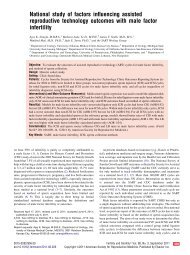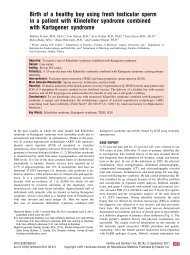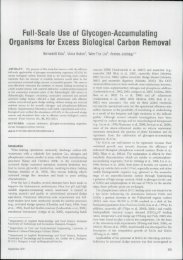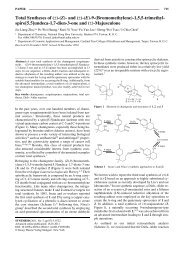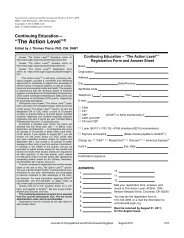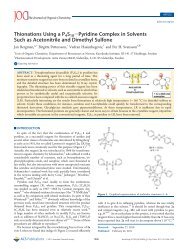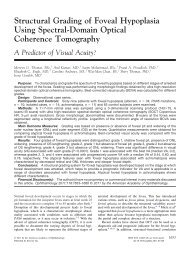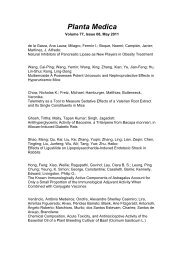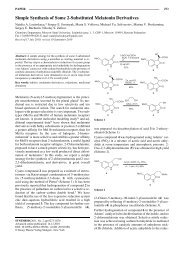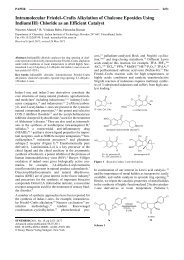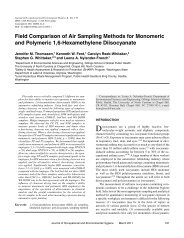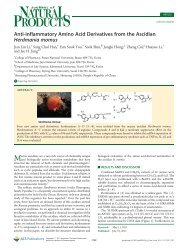Chemical Constituents and Pharmacological Properties of Poria cocos
Chemical Constituents and Pharmacological Properties of Poria cocos
Chemical Constituents and Pharmacological Properties of Poria cocos
You also want an ePaper? Increase the reach of your titles
YUMPU automatically turns print PDFs into web optimized ePapers that Google loves.
<strong>Chemical</strong> <strong>Constituents</strong> <strong>and</strong> <strong>Pharmacological</strong><br />
<strong>Properties</strong> <strong>of</strong> <strong>Poria</strong> <strong>cocos</strong><br />
Author José-Luis Ríos<br />
Affiliation Department <strong>of</strong> Pharmacology, University <strong>of</strong> Valencia, Valencia, Spain<br />
Key words<br />
l " <strong>Poria</strong> <strong>cocos</strong><br />
l " Polyporaceae<br />
l " polysaccharides<br />
l " triterpenes<br />
l " anti‑inflammatory activity<br />
l " anticancer activity<br />
l " immunomodulatory activity<br />
received Nov. 19, 2010<br />
revised January 25, 2011<br />
accepted January 31, 2011<br />
Bibliography<br />
DOI http://dx.doi.org/<br />
10.1055/s-0030-1270823<br />
Published online February 23,<br />
2011<br />
Planta Med 2011; 77: 681–691<br />
© Georg Thieme Verlag KG<br />
Stuttgart · New York ·<br />
ISSN 0032‑0943<br />
Correspondence<br />
Pr<strong>of</strong>. Dr. José-Luis Ríos<br />
Department <strong>of</strong> Pharmacology<br />
University <strong>of</strong> Valencia<br />
Av. Vicent Andres<br />
Estelles s/n<br />
46100 Burjassot<br />
Valencia<br />
Spain<br />
Phone: + 34 96354 49 73<br />
Fax: + 3496354 4998<br />
riosjl@uv.es<br />
Abstract<br />
!<br />
<strong>Poria</strong> <strong>cocos</strong> (Polyporaceae) is a saprophytic fungus<br />
that grows in diverse species <strong>of</strong> Pinus. Its sclerotium,<br />
called fu-ling or hoelen, is used in traditional<br />
Chinese <strong>and</strong> Japanese medicine for its diuretic,<br />
sedative, <strong>and</strong> tonic effects. Various studies <strong>of</strong> this<br />
fungus have demonstrated its marked anti-inflammatory<br />
activity in different experimental<br />
models <strong>of</strong> acute <strong>and</strong> chronic inflammation. It is<br />
widely used as a constituent <strong>of</strong> many preparations<br />
in Asian medicine, but the number <strong>of</strong> research<br />
papers on its clinical properties is insufficient<br />
for establishing its efficacy <strong>and</strong> safety from<br />
a scientific point <strong>of</strong> view. In this review, we have<br />
compiled all the published data concerning the<br />
chemistry, pharmacology, <strong>and</strong> clinical uses <strong>of</strong> this<br />
drug in order to evaluate its clinical interest for<br />
future use against various pathologies in which<br />
inflammation <strong>and</strong> immunodepression are implicated.<br />
We selected the papers for review on the basis<br />
<strong>of</strong> their ethnopharmacological relevance, using<br />
the most relevant databases for the biomedical sciences.<br />
Studies on various fungus extracts as well as<br />
on the major phytochemical compounds (polysaccharides<br />
<strong>and</strong> triterpenoids) present in <strong>Poria</strong> <strong>cocos</strong><br />
comprised the principal objectives <strong>of</strong> this review.<br />
In several <strong>of</strong> the studies reviewed, the inhibitory<br />
effects <strong>of</strong> triterpenes on phospholipase A 2 (PLA2)<br />
have been clearly demonstrated. In addition, the<br />
inhibitory effects <strong>of</strong> <strong>Poria</strong> <strong>cocos</strong> on the secretion <strong>of</strong><br />
different cytokines from human peripheral blood<br />
monocytes have also been described. Triterpenoids<br />
are known to have a pivotal influence on certain<br />
diseases such as rheumatoid arthritis, psoriasis,<br />
autoimmune uveitis, septic shock, <strong>and</strong> possibly<br />
bronchial asthma, while polysaccharides can potentiate<br />
the immune response. Reviewing the literature,<br />
we found that polysaccharides from <strong>Poria</strong><br />
<strong>cocos</strong> enhanced the secretion <strong>of</strong> immune stimulators<br />
<strong>and</strong> suppressed the secretion <strong>of</strong> immune suppressors,<br />
thus potentiating the immune response.<br />
Reviews<br />
In addition, they showed antitumor activity<br />
against different cancer cell lines. This activity is<br />
associated with their capacity to inhibit angiogenesis<br />
by downregulating both NF-κB <strong>and</strong> the induction<br />
<strong>of</strong> NF-κB/Rel translocation.<br />
Abbreviations<br />
!<br />
AAPH: 2,2′-azobis(2-amidinopropane)<br />
dihydrochloride<br />
Akt: a serine/threonine specific protein<br />
kinase family<br />
DMBA: 7,12-dimethylbenz[a]anthracen<br />
EBV‑EA: Epstein-Barr virus early antigen<br />
Erk: extracellular signal-regulated kinase<br />
GBM: glomerular basement membrane<br />
GM‑CSF: granulocyte-monocyte colony<br />
stimulating factor<br />
H‑ras: human gene that encodes proteins<br />
involved in the regulation <strong>of</strong> cell<br />
division in response to growth<br />
factor stimulation<br />
HBV: hepatitis B virus<br />
ID50: inhibitory dose-50<br />
IFN: interferon<br />
IL: interleukin<br />
PARP: poly(ADP-ribose)-polymerase<br />
PCM: <strong>Poria</strong> <strong>cocos</strong> mycelia<br />
PCP:<br />
PCPS <strong>and</strong><br />
<strong>Poria</strong> <strong>cocos</strong> protein<br />
PC‑PS: <strong>Poria</strong> <strong>cocos</strong> polysaccharide<br />
PCSC: polysaccharide from <strong>Poria</strong> <strong>cocos</strong><br />
sclerotium<br />
PLA2: phospholipase A<br />
PPAR: peroxisome proliferator-activated<br />
receptor<br />
TGF: transforming growth factor<br />
TNF: tumor necrosis factor<br />
TPA: 12-O-tetradecanoylphorbol<br />
13-acetate<br />
TLR4: Toll-like receptor 4<br />
Ríos J-L. <strong>Chemical</strong> <strong>Constituents</strong> <strong>and</strong> … Planta Med 2011; 77: 681–691<br />
681
682<br />
Reviews<br />
Taxonomical Classification <strong>and</strong> Biological Relevance<br />
!<br />
<strong>Poria</strong> <strong>cocos</strong> (Schw.) Wolf (Polyporaceae) is known by different botanical<br />
synonyms, such as Wolfiporia extensa (Peck) Ginns, Wolfiporia<br />
<strong>cocos</strong> (F. A. Wolf) Ryvarden & Gilb., Daedalea extensa Peck,<br />
Macrohyporia extensa (Peck) Ginns & J. Lowe, Macrohyporia <strong>cocos</strong><br />
(Schwein.) I. Johans. & Ryvarden, Sclerotium <strong>cocos</strong> Schwein., <strong>and</strong><br />
Pachyma <strong>cocos</strong> Fr. The genus is made up <strong>of</strong> species that possess<br />
simple septate hyphae, cause brown rots, <strong>and</strong> produce annual<br />
polyporoid fruiting bodies with hyaline spores [1]. These shared<br />
morphological <strong>and</strong> physiological characteristics have long been<br />
considered important in traditional polypore taxonomy; however,<br />
recent molecular work indicates that this genus falls within<br />
the “core polyporoid” class <strong>of</strong> true polypores [2]. The species <strong>of</strong><br />
this genus show microscopic similarities to other related species<br />
from closely related genera, such as Laetiporus, Phaeolus,<strong>and</strong>Pycnoporellus,<br />
despite producing macroscopic fruiting bodies that<br />
are thin, resupinate, <strong>and</strong> lacking in bright pigmentations [1].<br />
<strong>Poria</strong> <strong>cocos</strong> is dimitic <strong>and</strong> has greatly inflated skeletal hyphae, a<br />
defining characteristic <strong>of</strong> this genus [3]. This species gives large,<br />
edible sclerotia that have been referred to as “tuckahoes” or “Indian<br />
bread” in North America, where the name Wolfiporia <strong>cocos</strong><br />
is used. However, the name <strong>Poria</strong> <strong>cocos</strong> is preferred in Asia [1],<br />
where the sclerotium – called fu-ling in Chinese <strong>and</strong> hoelen in<br />
Japanese – is collected <strong>and</strong> used in traditional Chinese <strong>and</strong> Japanese<br />
medicine as a diuretic, sedative, <strong>and</strong> tonic [4].<br />
<strong>Poria</strong> <strong>cocos</strong> is a saprophytic fungus that grows in diverse Pinus<br />
species such as P. densiflora <strong>and</strong> P. mansoniana. In the wild it<br />
grows much like the European truffle, but other genera, such as<br />
Citrus, Eucalyptus, or Quercus, can be parasited [5]. Different<br />
parts <strong>of</strong> fu-ling are used in herbal medicine: the bark or fu-lingpi,<br />
the outermost layer next to the bark or chih-fu-ling, which is<br />
reddish in color, the middle layer or bai-fu-ling (or simply fuling),<br />
which is white in color, <strong>and</strong> the core or fu-shen, which includes<br />
the wood to which it is attached. Each crude drug obtained<br />
from <strong>Poria</strong> <strong>cocos</strong> has different properties [6].<br />
<strong>Chemical</strong> Composition<br />
!<br />
<strong>Poria</strong> <strong>cocos</strong> contains two principal groups <strong>of</strong> chemicals, the triterpene<br />
fraction <strong>and</strong> the polysaccharide fraction. Other minor compounds<br />
have also been described, including steroids, amino acids,<br />
choline, histidine, <strong>and</strong> potassium salts [5–7].<br />
Triterpenes<br />
Many triterpenes have been isolated from <strong>Poria</strong> <strong>cocos</strong>, almost all <strong>of</strong><br />
them derived from lanostane or secolanostane skeletons. During<br />
the past decade, Tai et al. [8–13] <strong>and</strong> other Chinese <strong>and</strong> Japanese<br />
research groups have isolated all the major known compounds<br />
from <strong>Poria</strong> <strong>cocos</strong>, including various triterpenes (l " Table 1). Recently,<br />
Akihisa et al. [14, 15] isolated 35 compounds, 20 previously<br />
known <strong>and</strong> 15 new structures from this species, while<br />
Zheng <strong>and</strong> Yang [16, 17] isolated 10 triterpenes, two <strong>of</strong> which –<br />
poriacosone A <strong>and</strong> poriacosone B – were new.<br />
The isolated triterpenes from <strong>Poria</strong> <strong>cocos</strong> could be considered derivatives<br />
from a lanostane skeleton; however, some differences<br />
have been observed. For example, many possess different structures<br />
derived from an eburicane skeleton (a C 21 lanostane with a<br />
methyl in C24) <strong>and</strong> they usually present one (at C8-C9) or two (at<br />
C7-C8 <strong>and</strong> C9-C11) unsaturated positions. Moreover, various compounds<br />
are derived from a 3,4-seco-lanostane <strong>and</strong> 3,4-seco-ebur-<br />
Ríos J-L. <strong>Chemical</strong> <strong>Constituents</strong> <strong>and</strong> … Planta Med 2011; 77: 681–691<br />
Table 1 Triterpenes isolated from <strong>Poria</strong> <strong>cocos</strong>.<br />
Lanostane-type triterpenes References<br />
Trametenolic acid [10]<br />
Dehydrotrametenolic acid (4) [18]<br />
3-epi-Dehydrotrametenolic acid [14]<br />
16α-Hydroxytrametenolic acid [19]<br />
3-O-Acetyl-16α-hydroxytrametenolic acid (5) [12]<br />
3-O-Acetyl-16α-hydroxydehydrotrametenolic acid [12]<br />
16α-27-Dihydroxydehydrotrametenoic acid [15]<br />
Dehydrotrametenonic acid (12) [20]<br />
3β,16α-Dihydroxylanosta-7,9(11),24-trien-21-oic acid<br />
Eburicane-type triterpenes<br />
[19]<br />
Eburicoic acid [21]<br />
Dehydroeburicoic acid (17) [10]<br />
16α-25-Dihydroxydehydroeburicoic acid [14]<br />
Dehydroeburiconic acid (11) [14]<br />
16α-Hydroxyeburiconic acid [14]<br />
16α-25-Dihydroxydehydroeburiconic acid [15]<br />
Pachymic acid (1) [21]<br />
Dehydropachymic acid (14) [9]<br />
3-epi-Dehydropachymic acid [12]<br />
16α-Hydroxydehydropachymic acid [19]<br />
25-Hydroxypachymic acid [16]<br />
Tumulosic acid (15) [21]<br />
Dehydrotumulosic acid (2) [21]<br />
3-epi-Dehydrotumulosic acid (16) [11]<br />
15α-Hydroxydehydrotumulosic acid [14]<br />
25-Hydroxy-3-epi-tumulosic acid [15]<br />
25-Hydroxy-3-epi-hydroxytumulosic acid [11]<br />
3β-Hydroxybenzoyldehydrotumulosic acid [18]<br />
5α-8α-Peroxydehydrotumulosic acid [14]<br />
Polyporenic acid C (13) [21]<br />
6α-Hydroxypolyporenic acid C (18) [22]<br />
29-Hydroxypolyporenic acid C [16]<br />
<strong>Poria</strong>cosone A [17]<br />
<strong>Poria</strong>cosone B<br />
seco-Lanostane-type triterpenes<br />
[17]<br />
Poricoic acid B (3) [8]<br />
16-Deoxyporicoic acid B (8) [14]<br />
Poricoic acid E [11]<br />
Poricoic acid BM [11]<br />
Poricoic acid G (6) [23]<br />
Poricoic acid GM<br />
seco-Eburicane-type triterpenes<br />
[15]<br />
Poricoic acid A (7) [8]<br />
Poricoic acid C (9) [14]<br />
Poricoic acid D [14]<br />
Poricoic acid F [11]<br />
Poricoic acid H [23]<br />
Poricoic acid AM [14]<br />
Poricoic acid CM [14]<br />
Poricoic acid DM [14]<br />
Poricoic acid HM [15]<br />
6,7-Dehydroporicoic acid H [15]<br />
25-Hydroxyporicoic acid C [15]<br />
25-Hydroxyporicoic acid H [14]<br />
26-Hydroxyporicoic acid DM [15]<br />
25-Methoxyporicoic acid A (10) [15]<br />
icane skeleton. These general structures are given in l " Fig. 1,<br />
with the most relevant active triterpenoids being shown in<br />
l " Fig. 2 <strong>and</strong> Table 1.
Polysaccharides<br />
Many different polysaccharides have been isolated from <strong>Poria</strong> <strong>cocos</strong>;<br />
however, because the nomenclature is not sufficiently clear,<br />
there are probably several names for the same compound. Before<br />
1980, various authors had already isolated a compound called βpachyman<br />
which was defined as (1 → 3)-(1 → 6)-β-D-glucan [24].<br />
Other authors subsequently obtained the derivatives later<br />
dubbed pachymaran, carboximethyl pachymaran, U-pachymaran<br />
f, <strong>and</strong> polysaccharide H 11, which exhibited different properties<br />
when they were tested <strong>and</strong> thus probably have different chemical<br />
configurations [25]. More recently, other authors have isolated<br />
different polysaccharides from <strong>Poria</strong> <strong>cocos</strong>; because these were<br />
more clearly defined, their chemical structure could be established<br />
unequivocally. For example, six polysaccharide fractions<br />
were isolated sequentially from the mycelia <strong>of</strong> a wild strain <strong>of</strong><br />
<strong>Poria</strong> <strong>cocos</strong> cultured in two media differing in one constituent, either<br />
bran extract or corn steep liquor, labeled wb <strong>and</strong> wc, respectively.<br />
From these, various extracts were obtained with 0.9% NaCl<br />
(PCM1), hot water (PCM2), 0.5 NaOH (PCM3 I <strong>and</strong> II), <strong>and</strong> 88% formic<br />
acid (PCM4 I <strong>and</strong> II). The heteropolysaccharides wb- <strong>and</strong> wc-<br />
PCM1 <strong>and</strong> PCM2 were mainly composed <strong>of</strong> α-D-glucose, mannose,<br />
<strong>and</strong> galactose, whereas wb-PCM3-I <strong>and</strong> wc-PCM3-I were<br />
mainly (1 → 3)-α-D-glucans. For their part, wb- <strong>and</strong> wc-PCM3-II,<br />
PCM4-I, <strong>and</strong> PCM4-II were all (1 → 3)-β-D-glucans. In addition,<br />
two exo-polysaccharides isolated from the two culture media<br />
via methanol precipitation (wb- <strong>and</strong> wc-PCM0) also differed in<br />
their monosaccharide composition [26].<br />
Recently, Wang et al. [27] isolated six polysaccharides from the<br />
sclerotium <strong>of</strong> <strong>Poria</strong> <strong>cocos</strong>, naming them PCS1, PCS2, PCS3-I,<br />
Reviews<br />
Fig. 1 General structures <strong>of</strong> triterpenoids from<br />
<strong>Poria</strong> <strong>cocos</strong>.<br />
PCS3-II, PCS4-I, <strong>and</strong> PCS4-II, depending on their solubility <strong>and</strong><br />
molecular weights. PCS1, PCS2, <strong>and</strong> PCS3-I were identified as<br />
heteropolysaccharides containing D-glucose, D-mannose, D-fucose,<br />
<strong>and</strong> traces <strong>of</strong> D-xylose. PCS3-I is a protein-bound heteropolysaccharide<br />
while PCS3-II is a linear (1 → 3)-β-D-glucan <strong>of</strong><br />
high purity that constitutes the main component <strong>of</strong> the sclerotium<br />
<strong>of</strong> <strong>Poria</strong> <strong>cocos</strong>. PCS4-I is a linked branched (1 → 3)-β-D-glucan<br />
with few β-(1 → 6), <strong>and</strong> PCS4-II is a linked branched (1 → 3)β-D-glucan<br />
with few β-(1 → 2) <strong>and</strong> β-(1 → 6). However, in a pilot<br />
scale facility-fermentation tank, a water-insoluble derivative<br />
with α configuration was isolated from <strong>Poria</strong> <strong>cocos</strong> mycelia,<br />
(1 → 3)-α-D-glucan, which was coded as Pi-PCM3-I [28].<br />
Other isolated compounds<br />
Ukiya et al. [23] described the isolation <strong>of</strong> dehydroabietic acid<br />
methyl ester, Akihisa et al. [15] that <strong>of</strong> 7-oxo-dyhydroxydehydroabietic<br />
acid, <strong>and</strong> Li et al. [29] the isolation <strong>of</strong> (S)-(+)-turmerone<br />
<strong>and</strong> ergosterol peroxide, along with other known triterpenoids.<br />
Other nonrelevant compounds have also been reported in<br />
<strong>Poria</strong> <strong>cocos</strong>, including hyperin, ergosterol, choline, histidine, <strong>and</strong><br />
potassium salts [6, 7], along with 15 amino acids [5].<br />
<strong>Pharmacological</strong> <strong>Properties</strong><br />
!<br />
Anti-inflammatory activity<br />
A hydroalcoholic extract from <strong>Poria</strong> <strong>cocos</strong> was found to inhibit<br />
the acute ear edema induced by 12-O-tetradecanoylphorbol 13acetate<br />
(TPA) <strong>and</strong> arachidonic acid, the paw edema induced by<br />
Ríos J-L. <strong>Chemical</strong> <strong>Constituents</strong> <strong>and</strong> … Planta Med 2011; 77: 681–691<br />
683
684<br />
Reviews<br />
carrageenan, the dermatitis induced by TPA, <strong>and</strong> the delayedtype<br />
hypersensitivity induced by oxazolone. Bioguided isolation<br />
<strong>of</strong> the active compounds led to the identification <strong>of</strong> two triterpenoids:<br />
pachymic acid (1) <strong>and</strong> dehydrotumulosic acid (2). These<br />
isolated compounds inhibited acute ear edema with ID 50 values<br />
<strong>of</strong> 4.7 <strong>and</strong> 0.68 nmol/ear, respectively, which indicates a considerable<br />
anti-inflammatory potency [30].<br />
Both compounds also inhibited the acute paw edema induced by<br />
phospholipase A 2 (PLA2) <strong>and</strong> serotonin while 2 reduced the ear<br />
edema induced by ethyl phenylpropiolate. Neither compound<br />
had any affect against arachidonic acid-induced acute ear edema.<br />
When compounds 1 <strong>and</strong> 2 were studied as possible corticoid-like<br />
agents, results showed a clear difference between them. Whereas<br />
the anti-edema activity <strong>of</strong> 2 was not affected by progesterone (a<br />
corticoid receptor antagonist), actinomycin D (an RNA transcription<br />
blocker), or cycloheximide (a protein synthesis inhibitor),<br />
Ríos J-L. <strong>Chemical</strong> <strong>Constituents</strong> <strong>and</strong> … Planta Med 2011; 77: 681–691<br />
Fig. 2 Active lanostanoids isolated from <strong>Poria</strong><br />
<strong>cocos</strong>.<br />
the activity <strong>of</strong> 1 was affected by progesterone <strong>and</strong>, to a lesser degree,<br />
by actinomycin D. These findings suggest that while the<br />
compounds do not act through a corticoid-like mechanism, in<br />
the case <strong>of</strong> 1, the corticoid receptor may be implicated [31]. The<br />
same authors reported the possible mechanism <strong>of</strong> action <strong>of</strong> the<br />
major triterpenoids isolated from the active extract. Compounds<br />
1 <strong>and</strong> 2 both showed significant inhibitory activity against PLA 2<br />
from Naja naja venom, with the latter exhibiting greater activity<br />
[32]. Extracellular PLA2 plays a pathogenic role both by causing<br />
direct damage to the cellular membrane through phospholipid<br />
hydrolysis <strong>and</strong> through the liberation <strong>of</strong> arachidonic acid, which<br />
is the precursor <strong>of</strong> many <strong>of</strong> the eicosanoids responsible for inflammatory<br />
responses. As such, PLA 2 may play a pivotal role in<br />
various diseases such as rheumatoid arthritis or psoriasis, thus<br />
making these triterpenoids potentially interesting as therapeutic<br />
agents. In similar work, Jain et al. [33] demonstrated that acidic
triterpenoids are inhibitors <strong>of</strong> PLA2. They studied the effects <strong>of</strong><br />
two derivatives, masticadienoic <strong>and</strong> masticadienolic acids, with<br />
regard to their interaction with three different forms <strong>of</strong> PLA2<br />
<strong>and</strong> demonstrated that both a bulk tetracyclic structure <strong>and</strong> a<br />
side alkyl carboxylic chain are necessary for rendering PLA2 inactive,<br />
although the latter part <strong>of</strong> the molecule seems to be the one<br />
that occupies <strong>and</strong> blocks the catalytic site <strong>of</strong> the enzyme. This hypothesis<br />
was supported by theoretical spatial considerations as<br />
well as by the fact that their homologous methyl esters are inactive.<br />
In the case <strong>of</strong> pachymic <strong>and</strong> dehydrotumulosic acids, the position<br />
<strong>of</strong> the free carboxylic group can vary (C 21 instead <strong>of</strong> C26)<br />
<strong>and</strong> the hybridization state <strong>of</strong> carbons C7−C10 can also admit<br />
some variation with no loss <strong>of</strong> activity. Cuéllar et al. [32] thus hypothesized<br />
that the alicyclic structure probably does not exert<br />
any spatially-specific function, but merely provides the lipophilicity<br />
needed to go along the hydrophobic channel leading to the<br />
active site <strong>of</strong> PLA2, as postulated by Scott et al. [34].<br />
In parallel, a second research group studied the effects <strong>of</strong> various<br />
isolated triterpenes on TPA-induced ear edema, obtaining similar<br />
results. For example, all the tested compounds inhibited the ear<br />
edemas induced by TPA <strong>and</strong> arachidonic acid, with similar potency<br />
values. They also tested a larger group <strong>of</strong> compounds, including<br />
seco-derivatives. Of these, poricoic acid B (3), showed<br />
the highest potency in the TPA test while dehydrotrametenolic<br />
acid (4) gave the best results in the arachidonic acid test [18, 35].<br />
In a previous study, Nukaya et al. [19] obtained similar results for<br />
the same or related compounds isolated from <strong>Poria</strong> <strong>cocos</strong>.<br />
Prieto et al. [36] reported the inhibition <strong>of</strong> leukotriene B 4 release<br />
by 1 <strong>and</strong> 2 that had previously been isolated from <strong>Poria</strong> <strong>cocos</strong>,<br />
with this effect being due to the inhibition <strong>of</strong> PLA2 rather than to<br />
a 5-lipoxygenase effect, as was reported by Cuéllar et al. [32].<br />
Fuchs et al. [37] studied the effects <strong>of</strong> three concentrations <strong>of</strong> <strong>Poria</strong><br />
<strong>cocos</strong> in a base cream which was tested on experimentally induced<br />
irritant contact dermatitis in a repeated sodium lauryl sulphate<br />
irritation model. Anti-inflammatory activity was reported<br />
for <strong>Poria</strong> <strong>cocos</strong> in all three experimental methods when the extracts<br />
were applied parallel to the induction period <strong>of</strong> irritant<br />
contact dermatitis. This effect can be explained by the influence<br />
<strong>of</strong> containing product on proinflammatory enzymes, such as<br />
PLA2, as previously reported by Cuéllar et al. [32]. These authors<br />
had demonstrated the effects <strong>of</strong> an ethanol extract <strong>of</strong> <strong>Poria</strong> <strong>cocos</strong><br />
on an experimental model <strong>of</strong> contact dermatitis induced by oxazolone.<br />
Since both 1 <strong>and</strong> 2 were isolated from this extract, the activity<br />
was associated with them [30].<br />
Immunomodulatory properties<br />
Certain medicinal plants <strong>and</strong> fungi, among them <strong>Poria</strong> <strong>cocos</strong>, are<br />
what are commonly referred to as immunomodulators, in that<br />
they alter the activity <strong>of</strong> immune function through the dynamic<br />
regulation <strong>of</strong> informational molecules such as cytokines [38].<br />
This property explains the effects <strong>of</strong> these plants on the immune<br />
system <strong>and</strong> other tissues. The most relevant research in this field<br />
is perhaps that <strong>of</strong> Yu <strong>and</strong> Tseng [39], who demonstrated, for example,<br />
that a 50% hot ethanol extract from <strong>Poria</strong> <strong>cocos</strong> increased<br />
the secretion <strong>of</strong> interleukin (IL)-1β <strong>and</strong> IL-6 in human peripheral<br />
blood monocytes in vitro in a dose-dependent manner 6 h after<br />
treatment. At a concentration <strong>of</strong> 0.4 mg/mL, the extract caused<br />
an increase in other cytokines, including tumor necrosis factor<br />
(TNF)-α. However, at 0.2 mg/mL it was found to suppress the secretion<br />
<strong>of</strong> transforming growth factor (TGF)-β 3 h after in vitro<br />
treatment. Four years before, Tseng <strong>and</strong> Chang [40] had demonstrated<br />
that a culture medium containing 10% <strong>of</strong> a <strong>Poria</strong> <strong>cocos</strong> ex-<br />
Reviews<br />
tract obtained with absolute ethanol inhibited IL-1β, IL-6, TNF-α,<br />
<strong>and</strong> granulocyte-monocyte colony stimulating factor (GM‑CSF)<br />
secretion from the monocyte monolayer; in contrast, a reduction<br />
in the <strong>Poria</strong> <strong>cocos</strong> content <strong>of</strong> the extract produced an increase in<br />
cytokine secretion.<br />
The increased secretion <strong>of</strong> IL-1β, IL-6, <strong>and</strong> TNF-α by activated<br />
macrophages potentiates the immune response. The inflammatory<br />
response is also associated with high levels <strong>of</strong> these three cytokines<br />
in serum secreted by activated neutrophils, because these<br />
three cytokines, which are secreted by activated neutrophils <strong>and</strong><br />
which stimulate the mononuclear phagocytes, are involved in fever<br />
<strong>and</strong> the acute phase <strong>of</strong> inflammation. TGF-β, on the other<br />
h<strong>and</strong>, suppresses the inflammatory response by inhibiting macrophage<br />
activation <strong>and</strong> the secretion <strong>of</strong> other cytokines [39]. Because<br />
the extract obtained from <strong>Poria</strong> <strong>cocos</strong> enhances the secretion<br />
<strong>of</strong> immune stimulators (IL-1β, IL-6, <strong>and</strong> TNF-α) <strong>and</strong> suppresses<br />
the secretion <strong>of</strong> an immune suppressor (TGF-β), it should<br />
serve to potentiate the immune response [39].<br />
From the dried sclerotium <strong>of</strong> <strong>Poria</strong> <strong>cocos</strong>, Chang et al. [41] isolated<br />
<strong>and</strong> purified a new immunomodulatory protein (PCP), which has<br />
a total <strong>of</strong> 35.6 kDa <strong>and</strong> consists <strong>of</strong> a disulfide-linked heterodimeric<br />
glycoprotein with two subunits with 14.3 <strong>and</strong> 21.3 kDa, respectively,<br />
<strong>and</strong> which exhibits N- <strong>and</strong>O-glycosylation. In vitro, this<br />
glycoprotein stimulated RAW 264.7 macrophages through the induction<br />
<strong>of</strong> TNF-α <strong>and</strong> IL-1β as well as through the regulation <strong>of</strong><br />
NF-κB-related gene expression. In primary mouse macrophages,<br />
PCP directly activated peritoneal cavity macrophages to induce<br />
Toll-like receptor 4 (TLR4)-mediated myeloid differentiation factor<br />
88 (MyD88)-dependent signaling. Moreover, the glycosylated<br />
portion <strong>of</strong> PCP was a key factor in PCP signaling through TLR4 in<br />
peritoneal macrophages. This glycoprotein, along with <strong>Poria</strong><br />
<strong>cocos</strong> itself, could thus be considered a new, potential immunostimulant.<br />
From the dried sclerotia powder <strong>of</strong> <strong>Poria</strong> <strong>cocos</strong>, Chen et al. [42]<br />
obtained a β-(1 → 3)-D-glucan coded as PCS3-II, from which they<br />
then obtained the corresponding carboxymethylated derivative<br />
(C‑PC3-II) <strong>and</strong> the carboxymethylated-sulfated derivative<br />
(CS‑PCS3-II). The immunopotentiation activity <strong>of</strong> all three compounds<br />
was evaluated <strong>and</strong> the activity-structure relationship<br />
was determined. CS‑PCS3-II was found to enhance the immune<br />
ability <strong>of</strong> the spleen <strong>and</strong> to increase the carbon clearance index<br />
<strong>of</strong> macrophages, the spleen <strong>and</strong> thymus weight index, hemolytic<br />
activity, spleen antibody production, <strong>and</strong> the delayed type hypersensitivity<br />
response in mice. The authors hypothesized that the<br />
coexistence <strong>of</strong> carboxymethyl <strong>and</strong> sulfate groups in CS‑PCS3-II<br />
molecules plays an important role in enhancing the immunomodulatory<br />
activity <strong>of</strong> this particular polysaccharide.<br />
Anticancer properties<br />
Kaminaga et al. [43] studied the inhibitory effects <strong>of</strong> lanostanetype<br />
triterpene acids from <strong>Poria</strong> <strong>cocos</strong> on tumor promotion by<br />
TPA in two-stage carcinogenesis in mouse skin, demonstrating<br />
that 1, 3,<strong>and</strong>3-O-acetyl-16α-hydroxytrametenolic acid (5) all inhibited<br />
the promoting effects <strong>of</strong> TPA on skin tumors after initiation<br />
with 7,12-dimethylbenz[a]anthracene (DMBA). In 2002,<br />
Ukiya et al. [23] tested the inhibitory effects <strong>of</strong> 10 triterpenes isolated<br />
from <strong>Poria</strong> <strong>cocos</strong> on the Epstein-Barr virus early antigen<br />
(EBV‑EA) activation induced by the tumor promoter TPA in Raji<br />
cells. The compounds all displayed activity, but subsequent evaluation<br />
<strong>of</strong> the cytotoxicity <strong>of</strong> the compounds poricoic acid G (6)<br />
<strong>and</strong> poricoic acid A (7) against human cancer cell lines revealed<br />
that the former was significantly cytotoxic to leukemia HL-60<br />
Ríos J-L. <strong>Chemical</strong> <strong>Constituents</strong> <strong>and</strong> … Planta Med 2011; 77: 681–691<br />
685
686<br />
Reviews<br />
cells at nM range (although it showed only moderate cytotoxicity<br />
against the other cell lines) while the latter compound exhibited<br />
only moderate cytotoxicity against all the cancer cell lines tested.<br />
Several years later, Akihisa et al. [14] used the same protocol to<br />
study a series <strong>of</strong> triterpenoids in vitro to evaluate their antitumor-promoting<br />
activity. All the tested compounds exhibited low<br />
cytotoxicity against Raji cells, with 13 showing high inhibitory effects<br />
<strong>and</strong> IC50 values <strong>of</strong> 195–340 mol ratio/32 pmol TPA. In the<br />
same study, the authors evaluated the inhibitory properties in<br />
vivo <strong>of</strong> two compounds, 16-deoxyporicoic acid B (8) <strong>and</strong> poricoic<br />
acid C (9), in a two-stage carcinogenesis test on mouse skin using<br />
DMBA as an initiator <strong>and</strong> TPA as a promoter. Eleven weeks after<br />
treatment, the percentage <strong>of</strong> papilloma-bearing mice in the<br />
treated groups was only 20% for 8 <strong>and</strong> 27% for 9, whereas after<br />
20 weeks the percentages were 80% <strong>and</strong> 87%, respectively. When<br />
the authors evaluated the average number <strong>of</strong> papillomas per<br />
mouse at 11 weeks it was 1.2 <strong>and</strong> 1.5, respectively, whereas at<br />
20 weeks it was 3.2 <strong>and</strong> 3.6, respectively. These findings, however,<br />
should be compared to those <strong>of</strong> the untreated group, which<br />
showed a 100% incidence <strong>of</strong> papillomas 11 weeks after promotion.<br />
From the results <strong>of</strong> both the in vitro EBV‑EA induction assay<br />
<strong>and</strong> the in vivo two-stage carcinogenesis test, the authors concluded<br />
that the lanostane-type triterpenes from the sclerotium<br />
<strong>of</strong> <strong>Poria</strong> <strong>cocos</strong>, especially those hydroxylated at C 16R <strong>and</strong>/or those<br />
with a 3,4-seco-3-oic acid functionality (l " Fig. 1), may serve as<br />
valuable chemopreventive agents against chemical carcinogenesis.<br />
Two years later, the same authors completed this study with<br />
11 compounds isolated from <strong>Poria</strong> <strong>cocos</strong>: 10 triterpenoids <strong>and</strong> 1<br />
diterpene. All showed inhibitory effects in vitro against TPA-induced<br />
EBV‑EA activation in Raji cells. However, in vivo only 25methoxyporicoic<br />
acid A (10) exhibited inhibitory activity in the<br />
two-stage carcinogenesis test. The authors concluded that while<br />
lanostane triterpenoids may be potentially chemopreventive,<br />
they are not effective antitumor agents [15].<br />
Mizushina et al. [44] studied the effects <strong>of</strong> 9 triterpene acids (4<br />
eburicane-type, 1 lanostane-type, 1 seco-lanostane, <strong>and</strong> 3 secoeburicane-type<br />
triterpenes) from <strong>Poria</strong> <strong>cocos</strong> as potential inhibitors<br />
<strong>of</strong> DNA polymerases <strong>and</strong> DNA topoisomerases from mammals.<br />
Among the tested compounds, only dehydroeburiconic acid<br />
(11) (described as dehydroebriconic acid in this paper) was detected<br />
as a possible inhibitor <strong>of</strong> DNA topoisomerase II activity,<br />
with a moderate inhibitory effect on the activity <strong>of</strong> other DNA<br />
polymerases. Dehydrotrametenonic acid (12) also showed a<br />
moderate inhibitory effect against topoisomerase II <strong>and</strong> a weak<br />
effect against all the polymerases tested. These findings suggest<br />
that 11 <strong>and</strong> 12 should be designated as topoisomerase II-preferential<br />
inhibitors, with moderate inhibitory effects against all the<br />
mammalian DNA polymerases tested. Both compounds also prevented<br />
the growth <strong>of</strong> human gastric cancers, halting them in the<br />
G 1 phase <strong>of</strong> the cell cycle. While both compounds have the same<br />
pattern <strong>of</strong> substitution (C3-keto, one carboxyl at C21, <strong>and</strong> no hydroxyl<br />
group), 12 has a lanostane skeleton whereas 11 has an<br />
eburicane one. The hydrophobic triterpene backbone <strong>and</strong> the hydrophilic<br />
carboxyl end <strong>of</strong> these compounds were able to bind to<br />
the hydrophobic sheet <strong>and</strong> the hydrophilic amino acids in DNA<br />
polymerase β, respectively. Both triterpenes showed an interesting<br />
spectrum <strong>of</strong> enzyme inhibition, <strong>and</strong> were able to recognize<br />
small structural differences among the binding sites on topoisomerases.<br />
These triterpenes may thus be useful tools for studying<br />
the microstructure <strong>of</strong> such binding sites <strong>and</strong> could be helpful<br />
in designing new drugs with the aid <strong>of</strong> computer simulation [44].<br />
Ríos J-L. <strong>Chemical</strong> <strong>Constituents</strong> <strong>and</strong> … Planta Med 2011; 77: 681–691<br />
From a bioactivity-guided fractionation <strong>of</strong> the methylene chloride<br />
extract from the sclerotium <strong>of</strong> <strong>Poria</strong> <strong>cocos</strong>, Li et al. [29] isolated<br />
6 compounds, three <strong>of</strong> which exhibited moderate cytotoxicity<br />
against a human colon carcinoma cell line; however, four <strong>of</strong><br />
the compounds – 1, polyporenic acid C (13), dehydropachymic<br />
acid (14), <strong>and</strong> tumulosic acid (15) – exhibited inhibitory activity<br />
against DNA topoisomerase II, as well as against DNA topoisomerase<br />
I. The activity <strong>of</strong> some <strong>of</strong> these compounds was related to<br />
the induction <strong>of</strong> apoptosis. For example, 11 <strong>and</strong> 12 inhibited calf<br />
DNA polymerase α <strong>and</strong> rat DNA polymerase β [20] while 4 selectively<br />
inhibited the growth <strong>of</strong> H‑ras transformed cells <strong>and</strong> induced<br />
apoptosis [45]. It also regulated the expression <strong>of</strong> H‑ras as<br />
well as that <strong>of</strong> Akt (a serine/threonine specific protein kinase<br />
family) <strong>and</strong> Erk (extracellular signal-regulated kinase), which<br />
are the downstream proteins <strong>of</strong> H‑ras signaling pathways. Another<br />
isolated compound from <strong>Poria</strong> <strong>cocos</strong>, 1, reduced cell proliferation<br />
<strong>and</strong> induced apoptosis in a dose- <strong>and</strong> time-dependent manner<br />
in <strong>and</strong>rogen-insensitive DU145 prostate cancer cells. Compound<br />
1-treatment decreased Bad phosphorylation, increased<br />
Bcl-2 phosphorylation, <strong>and</strong> activated caspase-9 <strong>and</strong> caspase-3,<br />
all <strong>of</strong> which, taken together, indicate that 1 initiates apoptosis by<br />
causing mitochondria dysfunction. Compound 1 also decreased<br />
the expression <strong>and</strong> activation <strong>of</strong> proteins within the Akt signaling<br />
pathway. These results, along with the compoundʼs previously reported<br />
inhibition <strong>of</strong> PLA 2 activity, led these authors to hypothesize<br />
a relationship between 1-influenced apoptosis <strong>and</strong> reduction<br />
<strong>of</strong> both prostagl<strong>and</strong>in synthesis <strong>and</strong> Akt activity, as PLA2 is elevated<br />
in prostatic adenocarcinoma <strong>and</strong> conversion <strong>of</strong> arachidonic<br />
acid to prostagl<strong>and</strong>ins leads to Akt pro-survival activity [46].<br />
Ling et al. [47] studied the effect <strong>of</strong> 13 on the growth <strong>of</strong> A549 nonsmall<br />
cell lung cancer cells (NSCLC) <strong>and</strong> demonstrated that it significantly<br />
reduces cell proliferation via the induction <strong>of</strong> apoptosis,<br />
as evidenced by sub-G 1 analysis, annexin V-FITC staining,<br />
<strong>and</strong> increases in the cleavage <strong>of</strong> procaspase-8, ‑3 <strong>and</strong> poly(ADPribose)-polymerase<br />
(PARP). However, treatment <strong>of</strong> cells with 13<br />
was not accompanied by either disruption <strong>of</strong> mitochondrial<br />
membrane potential or an increase in the cleavage <strong>of</strong> procaspase-9.<br />
Further, 13-induced apoptosis was inhibited by caspase-<br />
8 inhibitors, but not by a caspase-9 inhibitor. It also suppressed<br />
the PI3-kinase/Akt signal pathway <strong>and</strong> enhanced p53 activation.<br />
In conclusion, the results suggest that 13 induces apoptosis<br />
through the death receptor-mediated apoptotic pathway, in<br />
which the activation <strong>of</strong> caspase-8 leads to the direct cleavage <strong>of</strong><br />
execution caspases without the involvement <strong>of</strong> mitochondria.<br />
In 2004, Wu et al. [48] isolated 9 triterpenes from <strong>Poria</strong> <strong>cocos</strong> <strong>and</strong><br />
assayed their cytotoxic <strong>and</strong> antioxidant properties. None <strong>of</strong> the<br />
compounds showed any promising antioxidant activity, in agreement<br />
with data previously reported by Schinella et al. [49], but all<br />
<strong>of</strong> them except 15 showed cytotoxicity at different doses against<br />
human lung cancer cell line A549 <strong>and</strong> human prostate cancer cell<br />
line DU145 [50].<br />
Several authors have studied the antitumor activity <strong>of</strong> various<br />
polysaccharides isolated from <strong>Poria</strong> <strong>cocos</strong>. For example, Kanayama<br />
et al. [25] reported the effects <strong>of</strong> polysaccharide H 11 – a<br />
(1 → 3)-(1 → 6)-β-D-glucan in a ratio <strong>of</strong> 4:1 each <strong>and</strong> with a molecular<br />
weight <strong>of</strong> 5 × 10 6 – against subcutaneous sarcoma 180 at<br />
doses <strong>of</strong> 4 <strong>and</strong> 8 mg/kg × 10, but found that it had no effect on ascites<br />
sarcoma 180. The compound had an inhibition ratio <strong>of</strong> 96%<br />
with respect to the control group. The anticancer activity <strong>of</strong> <strong>Poria</strong><br />
<strong>cocos</strong>, along with its other effects, has been associated with its capacity<br />
to inhibit angiogenesis by downregulating NF-κB [51]. This<br />
effect has been studied with the polysaccharide fraction, <strong>and</strong> es-
pecially with the compound PCSC (polysaccharide from <strong>Poria</strong> <strong>cocos</strong><br />
sclerotium). This polysaccharide induces both the translocation<br />
<strong>of</strong> NF-κB/Rel into the nucleus <strong>and</strong> the binding <strong>of</strong> DNA to its<br />
cognate site in the promoter <strong>of</strong> the iNOS gene <strong>of</strong> activated macrophages<br />
[52]. In a later study, Lee et al. [53] demonstrated that<br />
PCSC induces NF-κB/Rel activation <strong>and</strong> iNOS expression through<br />
the CD14, TLR4, <strong>and</strong> CR3 membrane receptor <strong>and</strong> through p38 kinase,<br />
which is critical in the signal transduction leading to NF-κB/<br />
Rel activation in murine macrophages.<br />
Jin et al. [26, 54] studied 10 water-soluble heteropolysaccharide<br />
fractions obtained from <strong>Poria</strong> <strong>cocos</strong> mycelia cultured from one<br />
wild <strong>and</strong> one cultivated strain. Both the in vitro <strong>and</strong> in vivo antitumor<br />
activities <strong>of</strong> the heteropolysaccharides were evaluated <strong>and</strong><br />
compared. The authors found that the heteropolysaccharides<br />
from the wild strain cultured in a medium containing corn steep<br />
liquor exhibited the highest antitumor activities against sarcoma<br />
180 in vivo while the heteropolysaccharides from mycelium cultured<br />
in media with bran extract did not significantly inhibit tumor<br />
growth. Indeed, polysaccharides isolated from the different<br />
strains <strong>of</strong> <strong>Poria</strong> <strong>cocos</strong> mycelia (a series <strong>of</strong> compounds named<br />
PCM) generally seemed to have different in vivo <strong>and</strong> in vitro antitumor<br />
activities, depending on their monosaccharide composition,<br />
protein content, molecular mass, <strong>and</strong> chain conformation.<br />
Zhang et al. [55] studied the reported immune-enhancing <strong>and</strong><br />
antitumor activities <strong>of</strong> PCM3-II, a purified water-soluble β-glucan<br />
comprising mainly (1 → 3) <strong>and</strong> (1 → 4) linkages obtained from the<br />
mycelia <strong>of</strong> <strong>Poria</strong> <strong>cocos</strong>. PCM3-II reduced the proliferation <strong>and</strong> viability<br />
<strong>of</strong> human breast carcinoma MCF-7 cells in vitro in a dosedependent<br />
manner, decreasing the cancer-cell growth by 50% at<br />
400 µg/mL. The authors also studied the time effect <strong>of</strong> PCM3-II<br />
<strong>and</strong> found that the β-glucan arrested the cell cycle in the G 1<br />
phase, an effect associated with downregulation <strong>of</strong> the expression<br />
<strong>of</strong> cyclins D1 <strong>and</strong> E. In addition, PCM3-II induced the depletion<br />
<strong>of</strong> the anti-apoptotic Bcl-2 protein, but not the pro-apoptotic<br />
Bax protein.<br />
A water-insoluble (1 → 3)-β-D-glucan isolated from fresh sclerotium<br />
<strong>of</strong> <strong>Poria</strong> <strong>cocos</strong> was sulfated, carboxymethylated, methylated,<br />
hydroxyethylated, <strong>and</strong> hydroxypropylated to afford five watersoluble<br />
derivatives, respectively, to be tested against sarcoma<br />
180 tumor cells <strong>and</strong> a gastric carcinoma cell strain (MKN-45 <strong>and</strong><br />
SGC-7901), both in vitro <strong>and</strong> in vivo. Whereas the native β-glucan<br />
showed no antitumor activity, the sulfated <strong>and</strong> carboxymethylated<br />
derivatives exhibited significant antitumor activities<br />
against S-180 <strong>and</strong> gastric carcinoma tumor cells. The authors,<br />
Wang et al., hypothesized that these properties are based on<br />
good water solubility, relatively high chain stiffness, <strong>and</strong> the<br />
moderate molecular mass <strong>of</strong> the derivatives in aqueous solution<br />
[56]. This explanation is supported by the results <strong>of</strong> an experiment<br />
conducted by Zhang et al. [57] with the water-soluble heteropolysaccharide<br />
ac-PCM0 obtained from <strong>Poria</strong> <strong>cocos</strong>, which exhibited<br />
in vivo antitumor activity <strong>and</strong> showed a significantly<br />
higher enhancement ratio <strong>of</strong> body weight than 5-fluorouracil,<br />
with no cytotoxic effects.<br />
Two kinds <strong>of</strong> water-insoluble (1 → 3)-α-D-glucan samples, ab-<br />
PCM3-I <strong>and</strong> ac-PCM3-I, isolated from different <strong>Poria</strong> <strong>cocos</strong> mycelia<br />
were sulfated to obtain two series <strong>of</strong> water-soluble derivatives,<br />
ab-PCM3-I-S1-S5 <strong>and</strong> ac-PCM3-I-S1-S5, respectively. These were<br />
tested against sarcoma 180 tumor cells both in vitro <strong>and</strong> in vivo<br />
<strong>and</strong> displayed a significantly higher activity than those from the<br />
native α-D-glucans. Different structural features <strong>and</strong> the higher<br />
water solubility <strong>of</strong> the transformed products may explain the enhanced<br />
activity [58].<br />
Reviews<br />
The neutral polysaccharide fraction PCPS (<strong>Poria</strong> <strong>cocos</strong> polysaccharide,<br />
mw about 160 kDa) was studied for its effects on antiproliferation<br />
<strong>and</strong> differentiation <strong>of</strong> different human leukemic<br />
cells in vitro, with the results showing that it suppressed the cell<br />
proliferation <strong>of</strong> U937 <strong>and</strong> HL-60 cells. It also induced both U937<br />
cells <strong>and</strong> HL-60 cells to differentiate into mature monocytes/macrophages,<br />
which in turn markedly expressed the surface antigens<br />
<strong>of</strong> CD11b, CD14, <strong>and</strong> CD68. The differentiated U937 <strong>and</strong> HL-60<br />
cells exhibited physiological functions such as respiratory burst<br />
<strong>and</strong> phagocytosis. Moreover, the levels <strong>of</strong> interferon (IFN)-γ <strong>and</strong><br />
TNF-α were higher than those observed in the control group.<br />
Antibody neutralization tests demonstrated that the growth-inhibitory<br />
<strong>and</strong> differentiation-inducing activities were mainly due<br />
to the elevated levels <strong>of</strong> IFN-γ <strong>and</strong> TNF-α, suggesting that PCPS is a<br />
biological response modifier rather than a cytotoxic reagent <strong>and</strong><br />
could constitute a potential alternative in leukemia therapy [59].<br />
As commented above, Chen et al. [42] obtained a β-(1 → 3)-D-glucan<br />
(PCS3-II) from <strong>Poria</strong> <strong>cocos</strong>, along with its semisynthetic derivatives,<br />
carboxymethylated (C‑PC3-II) <strong>and</strong> the carboxymethylated-sulfated<br />
(CS‑PCS3-II). The authors studied the anticancer<br />
properties <strong>of</strong> these compounds in vivo on male BALB/c mice inoculated<br />
with sarcoma 180 (S-180) tumor cells. Microscopic examination<br />
<strong>of</strong> the tumor cells revealed signs <strong>of</strong> necrosis <strong>and</strong> apoptosis<br />
in cells treated with the carboxymethylated-sulfated derivative<br />
<strong>and</strong> enhancement <strong>of</strong> immune response in the spleen.<br />
The authors suggest that CS‑PCS3-II exerts this antitumor activity<br />
through immunomodulation.<br />
Antihyperglycemic effects<br />
Various studies have been published on the use <strong>of</strong> <strong>Poria</strong> <strong>cocos</strong>, either<br />
alone or in combination with other crude drugs, to treat diabetes.<br />
Li et al. [60] studied the antihyperglycemic effects <strong>of</strong> a<br />
methanol crude extract <strong>of</strong> <strong>Poria</strong> <strong>cocos</strong> on streptozocin-treated<br />
db/db mice. The extract reduced blood glucose via increased insulin<br />
sensitivity. Three fractions – chlor<strong>of</strong>orm, ethyl acetate, <strong>and</strong><br />
water extracts – were obtained from the crude extract, but only<br />
the first exhibited any activity. The authors then isolated three<br />
terpenoids (1, 2, <strong>and</strong>4), which they studied using the same protocol<br />
while also examining the effect <strong>of</strong> modifying/activating the<br />
peroxisome proliferator-activated receptor (PPAR)-γ pathway on<br />
the increase <strong>of</strong> insulin sensitivity. The authors found that neither<br />
the active extract nor the isolated triterpenes activated the PPARγ<br />
pathway <strong>and</strong> hypothesized that the compounds may instead affect<br />
5′-AMP activated protein kinase. Further studies have thus<br />
been proposed. However, in a previous study, Sato et al. [61] had<br />
demonstrated that 4 promotes adipocyte differentiation in vitro<br />
<strong>and</strong> acts as an insulin sensitizer in vivo. Indeed, the compound<br />
was found to reduce hyperglycemia in mouse models <strong>of</strong> noninsulin-dependent<br />
diabetes mellitus, acting as an insulin sensitizer,<br />
as demonstrated in the glucose tolerance test. It was also shown<br />
to induce adipose conversion, activate PPAR-γ in vitro, <strong>and</strong> reduce<br />
hyperglycemia in animal models <strong>of</strong> noninsulin-dependent diabetes<br />
mellitus. In addition, Su <strong>and</strong> Huang [62] demonstrated a positive<br />
effect <strong>of</strong> <strong>Poria</strong> <strong>cocos</strong> on the PPAR-γ pathway, with its ethyl<br />
acetate extract reversing the previous suppression <strong>of</strong> TNF-α on<br />
the PPAR-γ <strong>of</strong> human (LX-2) <strong>and</strong> rat (HSC‑T6) cells while enhancing<br />
the PPAR-γ activities <strong>of</strong> hepatic stellate cells. The extract also<br />
inhibited NF-κB activity induced by TNF-α <strong>and</strong> attenuated the<br />
TNF-α-induced protein <strong>and</strong> mRNA expression <strong>of</strong> α-smooth<br />
muscle actin.<br />
Recently, Huang et al. [63] demonstrated that 2, 13, 14, 15, 16,<br />
<strong>and</strong> especially 1 increase glucose uptake, GLU4 gene expression<br />
Ríos J-L. <strong>Chemical</strong> <strong>Constituents</strong> <strong>and</strong> … Planta Med 2011; 77: 681–691<br />
687
688<br />
Reviews<br />
at both mRNA <strong>and</strong> protein levels, <strong>and</strong> GLU4 translocation in 3T3-<br />
L1 adipocytes, but displayed no activity on GLU1 expression.<br />
Other pharmacological effects<br />
The antinephritic effect <strong>of</strong> the polysaccharide pachyman isolated<br />
from <strong>Poria</strong> <strong>cocos</strong> on original-type anti-glomerular basement<br />
membrane (anti-GBM) glomerulonephritis in rats was investigated<br />
by Hattori et al. [64]. The authors demonstrated its effects<br />
against original-type anti-GBM nephritis in rats <strong>and</strong> concluded<br />
that the antinephritic mechanisms <strong>of</strong> pachyman may partly be<br />
due to the inhibitory action <strong>of</strong> this agent on C3 deposition in the<br />
glomeruli.<br />
Dhan et al. [65] reported the effect <strong>of</strong> carboxymethyl pachymaram<br />
from <strong>Poria</strong> <strong>cocos</strong> on the anti-hepatitis B virus (HBV) expression<br />
from transfected cells.<br />
A hydroethanolic extract from <strong>Poria</strong> <strong>cocos</strong> was tested against the<br />
epimastigote <strong>of</strong> a Trypanosoma cruzi Bra C15C2 clone in vitro. It<br />
showed significant effects against the parasite, inhibiting growth<br />
by 30% [66].<br />
Li et al. [67] were the first to demonstrate the nematicidal activity<br />
<strong>of</strong> <strong>Poria</strong> <strong>cocos</strong>, which was able to kill more than 90% <strong>of</strong> the saprophytic<br />
nematode Panagrellus redivivue, the root-knot nematode<br />
Meloidogyne arenaria, <strong>and</strong> the pine nematode Bursaphelenchus<br />
xylophilus. From the active extract, three new compounds were<br />
isolated <strong>and</strong> identified as 2,4,6-triacetylenic octane diacid,<br />
2,4,5,6-tetrahydroxyhexanoic acid, <strong>and</strong> 3,4-dihydroxy-2-keto-nbutyl-2,4,5,6-tetrahydroxyhexanate.<br />
The first compound exhibited<br />
the highest activity.<br />
In an in vivo study, Zhang et al. [68] demonstrated the anti-rejection<br />
effect <strong>of</strong> the ethanol extract <strong>of</strong> <strong>Poria</strong> <strong>cocos</strong> at two different<br />
doses in rats after cardiac allograft implantation. The survival<br />
time <strong>of</strong> donor hearts in the two experimental groups was significantly<br />
prolonged by approximately 130% <strong>and</strong> 330% (in days) with<br />
respect to the control group. There was a clear reduction <strong>of</strong> pathological<br />
lesions in the two extract-treated groups, with the percentages<br />
<strong>of</strong> CD3+, CD4+, <strong>and</strong> CD8+ lymphocytes <strong>and</strong> the CD4+/CD8+<br />
ratio all being significantly lower.<br />
In vitro studies demonstrated that a methanol extract from <strong>Poria</strong><br />
<strong>cocos</strong> protected red blood cells from the hemolysis induced by the<br />
hydrophilic radical generator 2,2′-azobis(2-amidinopropane) dihydrochloride<br />
(AAPH); from this extract, Sekiya et al. [69] isolated<br />
five triterpene carboxylic acids – 1, 4, 5, 13, <strong>and</strong> 3-epi-dehydrotumulosic<br />
acid (16) – which were found to inhibit AAPH-induced<br />
lysis <strong>of</strong> red blood cells.<br />
The effect <strong>of</strong> <strong>Poria</strong> <strong>cocos</strong> on cytosolic free calcium concentration<br />
in the brain nerve cells <strong>of</strong> neonatal rats was investigated by Chen<br />
et al. [70]. Working with a water extract, the authors demonstrated<br />
that the plant increased cytosolic free calcium in a dose-dependent<br />
manner, except at high doses. Moreover, the extract inhibited<br />
the increase <strong>of</strong> cytosolic free calcium induced by high<br />
doses <strong>of</strong> glutamate. Similar results were observed in experiments<br />
with primarily cultured hippocampal neurons <strong>of</strong> neonatal rats.<br />
The authors concluded that the water extract <strong>of</strong> <strong>Poria</strong> <strong>cocos</strong> exerts<br />
bidirectional regulation <strong>of</strong> cytosolic free calcium in brain<br />
nerve cells.<br />
The antagonistic effects <strong>of</strong> <strong>Poria</strong> <strong>cocos</strong> on the ototoxicity <strong>of</strong> kanamycin<br />
in guinea-pigs was studied by Liu et al. [71], who infused<br />
the decoction into the guinea-pigs <strong>and</strong> compared the differences<br />
in the general intoxicating symptom, the prayerʼs reflex threshold,<br />
brainstem auditory evoked potentials, <strong>and</strong> the absence rate<br />
<strong>of</strong> outer hair cells in the first turn <strong>of</strong> the cochlea. The authors con-<br />
Ríos J-L. <strong>Chemical</strong> <strong>Constituents</strong> <strong>and</strong> … Planta Med 2011; 77: 681–691<br />
cluded that <strong>Poria</strong> <strong>cocos</strong> may serve as a good antagonistic agent in<br />
kanamycin treatment.<br />
Tai et al. [13] studied the anti-emetic properties <strong>of</strong> an ethanolic<br />
extract from <strong>Poria</strong> <strong>cocos</strong> <strong>and</strong> 17 triterpenoids (11 natural products<br />
isolated from the fungus <strong>and</strong> 6 semisynthetic derivatives).<br />
Using copper sulfate as an emetic agent in frogs, the authors<br />
demonstrated that the ethanolic extract, along with 1, its methyl<br />
ester, 7, <strong>and</strong> its dimethyl derivative all had anti-emetic properties;<br />
however, the last compound exhibited the highest activity<br />
at the lowest dose. In addition, 13 showed a high degree <strong>of</strong> toxicity.<br />
The authors concluded that triterpenes with an exo-methylene<br />
group at C 24 in their side-chain (eburicanes) have anti-emetic<br />
properties.<br />
Lee et al. [72] recently studied the effects <strong>of</strong> 1, dehydroeburicoic<br />
acid (17) (the names <strong>of</strong> these compounds are changed here with<br />
respect to the formula), <strong>and</strong> 4 (called 3β-hydroxylanosta-7,9<br />
(11),24-trien-21-oic acid in this paper) on human 5-hydroxytryptamine<br />
3A (5-HT3A) receptor channel activity. The three triterpenoids<br />
inhibited the 5HT-induced inward current (I5-HT) ina<br />
concentration dependent <strong>and</strong> reversible manner, with IC50 values<br />
<strong>of</strong> 3.2, 5.5, <strong>and</strong> 1.4 µM, respectively. While the inhibition <strong>of</strong><br />
I5-HT by the triterpenoids occurred in a noncompetitive manner,<br />
the inhibition by 1 <strong>and</strong> 4 showed greater voltage-dependency.<br />
These results indicate that triterpenoids may regulate the expressed<br />
5-HT3A receptors in Xenopus oocytes <strong>and</strong> that this regulation<br />
may be partly responsible for the pharmacological effects <strong>of</strong><br />
<strong>Poria</strong> <strong>cocos</strong>. These results suggest that these compounds could be<br />
used in therapeutics for the suppression <strong>of</strong> clinical symptoms related<br />
with activity <strong>of</strong> 5-HT 3A receptor, such as vomiting <strong>and</strong> visceral<br />
pain.<br />
Wang et al. [73] isolated a water-insoluble β-(1 → 3)-D-glucan<br />
from the sclerotium <strong>of</strong> <strong>Poria</strong> <strong>cocos</strong> <strong>and</strong> synthesized a carboxymethylated<br />
derivative. They demonstrated that carboxymethylation<br />
enhances the bile acid binding capacity <strong>of</strong> the polysaccharides<br />
in vitro, probably due to the improved water solubility <strong>and</strong><br />
structural changes caused by carboxymethylation. In addition,<br />
the semisynthetic derivative exhibited an increased antioxidant<br />
activity with respect to the original compound. The authors hypothesized<br />
that the carboxymethylated derivative could provide<br />
several health benefits, including reduction <strong>of</strong> cholesterol <strong>and</strong><br />
blood pressure.<br />
The antioxidant effects <strong>of</strong> a water soluble extract from <strong>Poria</strong> <strong>cocos</strong><br />
(PCW) <strong>and</strong> its effect on β-amyloid-induced neurotoxicity on rat<br />
pheochromocytoma (PC12) cells was studied by Park et al. [74],<br />
who suggested that PCW may protect cells by suppressing both<br />
the oxidative stress <strong>and</strong> the apoptosis induced by β-amyloid (1–<br />
42). Indeed, the pretreatment <strong>of</strong> PC12 cells with PCW within the<br />
concentration range <strong>of</strong> 5–125 µg/mL reduced β-amyloid (1–42)induced<br />
cell death. In addition, cells treated with PCW attenuated<br />
β-amyloid (1–42)-induced cytotoxicity, apoptotic features, <strong>and</strong><br />
accumulation <strong>of</strong> intracellular oxidative damage while decreasing<br />
the expression <strong>of</strong> the apoptotic protein Bax <strong>and</strong> the activity <strong>of</strong><br />
caspase-3. It also enhanced the expression <strong>of</strong> anti-apoptotic protein<br />
Bcl-2. Taken together, these findings suggest that PCW may<br />
be a potential natural agent against Alzheimerʼs disease.<br />
Pharmacokinetic Studies <strong>and</strong> Therapeutic Use<br />
!<br />
<strong>Poria</strong> <strong>cocos</strong> is a well-known traditional Chinese medicine used for<br />
its diuretic, sedative, <strong>and</strong> tonic effects [32]; indeed, it has been<br />
demonstrated to have spleen-invigorative, stomach-tonifying,
sedative, tranquilizing, diuretic, <strong>and</strong> damp-clearing effects. It is<br />
mainly used to treat retention <strong>of</strong> phlegm <strong>and</strong> fluid, dysuria, edema,<br />
poor appetite with watery stool, palpitations, <strong>and</strong> insomnia<br />
[7]. There are different specifications in the traditional use depending<br />
on the crude drug used; for example, fu-ling-pi promotes<br />
diuresis <strong>and</strong> reduces swelling whereas chih-fu-ling cleanses heat<br />
<strong>and</strong> eliminates dampness [6].<br />
<strong>Poria</strong> <strong>cocos</strong> has no adverse reactions described in the literature;<br />
however, it is not recommended in the case <strong>of</strong> polyuria.<br />
Using the human colonic adenocarcinoma (Caco-2) cell monolayer<br />
as an intestinal epithelial cell model, Zheng <strong>and</strong> Yang [75]<br />
studied the permeability <strong>of</strong> 13, 16, <strong>and</strong>6α-hydroxypolyporenic<br />
acid C (18) from the apical to the basolateral side <strong>and</strong> vice-versa.<br />
The transport parameters <strong>and</strong> apparent permeability coefficient<br />
values <strong>of</strong> 13 <strong>and</strong> 16 were nearly <strong>of</strong> the same magnitude as those<br />
<strong>of</strong> the st<strong>and</strong>ard drug propranolol while those for 18 lay between<br />
those <strong>of</strong> propranolol <strong>and</strong> atenolol (the reference drugs used in<br />
the experiments). Moreover, the efflux transport <strong>of</strong> 13 <strong>and</strong> 16<br />
were higher than their influx transport. The authors concluded<br />
that while all three compounds can be absorbed across intestinal<br />
epithelial cells, 13 <strong>and</strong> 16 could be completely absorbed whereas<br />
18 could only be moderately absorbed.<br />
In a similar study, the same authors [76] demonstrated that 1<br />
could be transported through the Caco-2 cell monolayer in a concentration-dependent<br />
manner <strong>and</strong> that the transport was linear<br />
with time. The absorption in the apical to basolateral direction<br />
<strong>and</strong> the secretion in the opposite direction were both poor, with<br />
the transport parameters <strong>and</strong> apparent permeability coefficient<br />
values being comparable to those <strong>of</strong> the reference drug atenolol.<br />
Although the diffusion <strong>of</strong> 1 was passive, ATP was partially involved<br />
in its transport.<br />
Commercial Products <strong>and</strong> Form <strong>of</strong> Administration<br />
!<br />
<strong>Poria</strong> <strong>cocos</strong> is present in the market under the names fu-ling, hoelen,<br />
poria, tuckahoe, <strong>and</strong> Indian bread. It is normally white in color<br />
(“white poria”), but there is a light red variant called “red poria”.<br />
In China, <strong>Poria</strong> <strong>cocos</strong> is one <strong>of</strong> the major ingredients <strong>of</strong> Bu-<br />
Chy, a drug which has long been used to aid in the recovery from<br />
chronic diseases. The sclerotium is presented in different commercial<br />
forms such as dry power <strong>and</strong> capsules. It is available in<br />
Western markets as a phytomedicine or as a natural dietary supplement,<br />
<strong>and</strong> is either presented alone or in combination with<br />
other medicinal plants or fungi. Dry powder <strong>of</strong> <strong>Poria</strong> <strong>cocos</strong> sclerotium<br />
is used in infusions at daily doses <strong>of</strong> 6–18 g. For reinforcing<br />
the spleen <strong>and</strong> the stomach, the recommended daily dose is 9 to<br />
18 g whereas for edema the dose may range as high as 30 to 45 g.<br />
As a sedative or for the treatment <strong>of</strong> palpitations <strong>and</strong> insomnia,<br />
the recommended dose is from 3 to 9 g [6, 7].<br />
Conclusions<br />
!<br />
Several pharmacological effects <strong>of</strong> <strong>Poria</strong> <strong>cocos</strong> have been clearly<br />
demonstrated in experimental studies. Of these, it is important<br />
to distinguish between anti-inflammatory <strong>and</strong> immunostimulant<br />
effects. Although the crude drug has been studied with regard<br />
to both properties, experimental studies show that purified<br />
extracts achieve the best effect. Thus, while anti-inflammatory<br />
activity has been clearly demonstrated for the triterpene-en-<br />
Reviews<br />
riched fraction, immunomodulation is correlated with the<br />
polysaccharide-enriched fractions. In the case <strong>of</strong> anticancer<br />
properties, both groups <strong>of</strong> compounds are implicated, triterpenes<br />
as cytotoxic principles <strong>and</strong> polysaccharides as immunostimulants.<br />
With respect to clinical data, no relevant reports on the extract<br />
or its isolated compounds are generally cited, only studies<br />
carried out within traditional Chinese medicine; however, these<br />
usually employ drug mixtures, such as STA-1 (a mixture <strong>of</strong> 10<br />
crude drugs) for treating allergic asthma [77] or Yi-jin (a mixture<br />
with 3 other crude drugs) for treating diabetes mellitus type II<br />
[78]. With regard to the potential cytotoxicity <strong>of</strong> <strong>Poria</strong> <strong>cocos</strong>, no<br />
reports have appeared in the literature. This fungus is usually administered<br />
in China at high doses (up to 45 g), with no specification<br />
<strong>of</strong> adverse effects, although the Chinese Pharmacopoeia lists<br />
several contraindications, such as in cases <strong>of</strong> polyuria, spermatorrhoea,<br />
or urogenital prolapse [79].<br />
References<br />
1 Lindner DL, Banik MT. Molecular phylogeny <strong>of</strong> Laetiporus <strong>and</strong> other<br />
brown rot polypore genera in North America. Mycologia 2008; 100:<br />
417–430<br />
2 Binder M, Hibbett DS, Larsson KH, Larsson E, Langer E, Langer G. The<br />
phylogenetic distribution <strong>of</strong> resupinate forms across the major clades<br />
<strong>of</strong> mushroom-forming fungi (Homobasidiomycetes). Syst Biodivers<br />
2005; 3: 113–157<br />
3 Ryvarden L. Genera <strong>of</strong> polypores: nomenclature <strong>and</strong> taxonomy. Synopsis<br />
fungorum 5. Oslo: Fungiflora; 1991: 363<br />
4 Giner-Larza EM, Máñez S, Giner-Pons RM, Carmen Recio M, Ríos JL. On<br />
the anti-inflammatory <strong>and</strong> anti-phospholipase A 2 activity <strong>of</strong> extracts<br />
from lanostane-rich species. J Ethnopharmacol 2000; 73: 61–69<br />
5 Illana-Esteban C. Interés medicinal de <strong>Poria</strong> <strong>cocos</strong> (= Wolfiporia extensa).<br />
Rev Iberoam Micol 2009; 26: 103–107<br />
6 Hsu HY, Chen YP, Shen SJ, Hsu CS, Chen CC, Chang HC. Oriental Materia<br />
Medica. A concise guide. Long Beach: Oriental Healing Arts Institute;<br />
1986: 305–306<br />
7 Chang HM, But PPH. Pharmacology <strong>and</strong> applications <strong>of</strong> Chinese Materia<br />
Medica. Singapore: World Scientific; 1987: 875–877<br />
8 Tai T, Akahori A, Shingu T. Triterpenoids from <strong>Poria</strong> <strong>cocos</strong>. Phytochemistry<br />
1991; 30: 2796–2797<br />
9 Tai T, Akahori A, Shingu T. A lanostane triterpenoid from <strong>Poria</strong> <strong>cocos</strong>.<br />
Phytochemistry 1992; 31: 2548–2549<br />
10 Tai T, Akahori A, Shingu T. Triterpenes <strong>of</strong> <strong>Poria</strong> <strong>cocos</strong>. Phytochemistry<br />
1993; 32: 1239–1244<br />
11 Tai T, Shingu T, Kikuchi T, Tezuka Y, Akahori A. Triterpenes from the surface<br />
layer <strong>of</strong> <strong>Poria</strong> <strong>cocos</strong>. Phytochemistry 1995; 39: 1165–1169<br />
12 Tai T, Shingu T, Kikuchi T, Tezuka Y, Akahori A. Isolation <strong>of</strong> lanostanetype<br />
triterpene acids having an acetoxyl group from sclerotia <strong>of</strong> <strong>Poria</strong><br />
<strong>cocos</strong>. Phytochemistry 1995; 40: 225–231<br />
13 Tai T, Akita Y, Konoshita K, Koyama K, Takahashi K, Watanabe K. Antiemetic<br />
principles <strong>of</strong> <strong>Poria</strong> <strong>cocos</strong>. Planta Med 1995; 61: 527–530<br />
14 Akihisa T, Nakamura Y, Tokuda H, Uchiyama E, Suzuki T, Kimura Y, Uchikura<br />
K, Nishi H. Triterpene acids from <strong>Poria</strong> <strong>cocos</strong> <strong>and</strong> their anti-tumorpromoting<br />
effects. J Nat Prod 2007; 70: 948–953<br />
15 Akihisa T, Uchiyama E, Kikuchi T, Tokuda H, Suzuki T, Kimura Y. Anti-tumor-promoting<br />
effects <strong>of</strong> 25-methoxyporicoic acid A <strong>and</strong> other triterpene<br />
acids from <strong>Poria</strong> <strong>cocos</strong>. J Nat Prod 2009; 72: 1786–1792<br />
16 Zheng Y, Yang XW. Two new lanostane triterpenoids from <strong>Poria</strong> <strong>cocos</strong>.<br />
J Asian Nat Prod Res 2008; 10: 323–328<br />
17 Zheng Y, Yang XW. <strong>Poria</strong>cosones A <strong>and</strong> B: two new lanostane triterpenoids<br />
from <strong>Poria</strong> <strong>cocos</strong>. J Asian Nat Prod Res 2008; 10: 645–651<br />
18 Yasukawa K, Kaminaga T, Kitanaka S, Tai T, Nunoura Y, Natori S, Takido<br />
M. 3β-p-hydroxybenzoyldehydrotumulosic acid from <strong>Poria</strong> <strong>cocos</strong>, <strong>and</strong><br />
its anti-inflammatory effects. Phytochemistry 1998; 48: 1357–1360<br />
19 Nukaya H, Yamashiro H, Fuzakawa H, Ishida H, Tsuji K. Isolation <strong>of</strong> inhibitors<br />
<strong>of</strong> TPA-induced mouse ear edema from hoelen, <strong>Poria</strong> <strong>cocos</strong>.<br />
Chem Pharm Bull 1996; 44: 847–849<br />
20 Akihisa T, Mizushina Y, Ukiya M, Oshikubo M, Kondo S, Kimura Y, Suzuki<br />
T, Tai T. Dehydrotrametenonic acid <strong>and</strong> dehydroeburiconic acid from<br />
<strong>Poria</strong> <strong>cocos</strong> <strong>and</strong> their inhibitory effects on eukaryotic DNA polymerase<br />
α <strong>and</strong> β. Biosci Biotechnol Biochem 2004; 68: 448–450<br />
Ríos J-L. <strong>Chemical</strong> <strong>Constituents</strong> <strong>and</strong> … Planta Med 2011; 77: 681–691<br />
689
690<br />
Reviews<br />
21 Yokoyama A, Natori S, Aoshima K. Distribution <strong>of</strong> tetracyclic triterpenoids<br />
<strong>of</strong> lanostane group <strong>and</strong> sterols in the higher fungi especially <strong>of</strong><br />
the Polyporaceae <strong>and</strong> related families. Phytochemistry 1975; 14: 487–<br />
497<br />
22 Zheng Y, Yang XW. Absorption <strong>of</strong> triterpenoid compounds from Indian<br />
bread (<strong>Poria</strong> <strong>cocos</strong>) across human intestinal epithelial (Caco-2) cells in<br />
vitro. Zhongguo Zhong Yao Za Zhi 2008; 33: 1596–1601<br />
23 Ukiya M, Akihisa T, Tokuda H, Hirano M, Oshikubo M, Nobukuni Y, Kimura<br />
Y, Tai T, Kondo S, Nishino H. Inhibition <strong>of</strong> tumor-promoting effects<br />
by poricoic acids G <strong>and</strong> H <strong>and</strong> other lanostane-type triterpenes <strong>and</strong> cytotoxic<br />
activity <strong>of</strong> poricoic acids A <strong>and</strong> G from <strong>Poria</strong> <strong>cocos</strong>. JNatProd<br />
2002; 65: 462–465<br />
24 Chihara G, Hamuro J, Maeda Y, Arai Y, Fukuoka F. Antitumor polysaccharide<br />
derived chemically from natural glucan (pachyman). Nature<br />
1970; 225: 943–944<br />
25 Kanayama H, Adechi N, Togami M. A new antitumor polysaccharide<br />
from the mycelia <strong>of</strong> <strong>Poria</strong> <strong>cocos</strong> Wolf. Chem Pharm Bull 1983; 31:<br />
1115–1118<br />
26 Jin Y, Zhang L, Chen L, Chen Y, Cheung PC, Chen L. Effect <strong>of</strong> culture media<br />
on the chemical <strong>and</strong> physical characteristics <strong>of</strong> polysaccharides isolated<br />
from <strong>Poria</strong> <strong>cocos</strong> mycelia. Carbohydr Res 2003; 338: 1507–1515<br />
27 Wang Y, Zhang M, Ruan D, Shashkov AS, Kilcoyne M, Savage AV, Zhang L.<br />
<strong>Chemical</strong> components <strong>and</strong> molecular mass <strong>of</strong> six polysaccharides isolated<br />
from the sclerotium <strong>of</strong> <strong>Poria</strong> <strong>cocos</strong>. Carbohydr Res 2004; 339:<br />
327–334<br />
28 Huang Q, Zhang L. Solution properties <strong>of</strong> (1 → 3)-α‑D-glucan <strong>and</strong> its<br />
sulfated derivative from <strong>Poria</strong> <strong>cocos</strong> mycelia via fermentation tank. Biopolymers<br />
2005; 79: 28–38<br />
29 Li G, Xu ML, Lee CS, Woo MH, Chang HW, Son JK. Cytotoxicity <strong>and</strong> DNA<br />
topoisomerases inhibitory activity <strong>of</strong> constituents from the sclerotium<br />
<strong>of</strong> <strong>Poria</strong> <strong>cocos</strong>. Arch Pharm Res 2004; 27: 829–833<br />
30 Cuéllar MJ, Giner RM, Recio MC, Just MJ, Máñez S, Ríos JL. Effect <strong>of</strong> the<br />
basidiomycete <strong>Poria</strong> <strong>cocos</strong> on experimental dermatitis <strong>and</strong> other inflammatory<br />
conditions. Chem Pharm Bull (Tokyo) 1997; 45: 492–494<br />
31 Giner EM, Máñez S, Recio MC, Giner RM, Cerdá-Nicolás M, Ríos JL. In vivo<br />
studies on the anti-inflammatory activity <strong>of</strong> pachymic <strong>and</strong> dehydrotumulosic<br />
acids. Planta Med 2000; 66: 221–227<br />
32 Cuéllar MJ, Giner RM, Recio MC, Just MJ, Máñez S, Ríos JL. Two fungal lanostane<br />
derivatives as phospholipase A2 inhibitors. J Nat Prod 1996; 59:<br />
977–979<br />
33 Jain MK, Yu B, Rogers JM, Smith AE, Boger ETA, Ostr<strong>and</strong>er RL, Rheingold<br />
AL. Specific competitive inhibitor <strong>of</strong> secreted phospholipase A 2 from<br />
berries <strong>of</strong> Schinus terebinthifolius. Phytochemistry 1995; 39: 537–547<br />
34 Scott DL, White SP, Otwinowski Z, Yuan W, Gelb MH, Sigler PB. Interfacial<br />
catalysis: the mechanism <strong>of</strong> phospholipase A 2. Science 1990; 250:<br />
1541–1546<br />
35 Kaminaga T, Yasukawa K, Takido M, Tai T, Nunoura Y. Inhibitory effects<br />
<strong>of</strong> <strong>Poria</strong> <strong>cocos</strong> on 12-O-tetradecanoylphorbol-13-acetate-induced eat<br />
oedema <strong>and</strong> tumour promotion in mouse skin. Phytother Res 1996;<br />
10: 581–584<br />
36 Prieto JM, Recio MC, Giner RM, Máñez S, Giner-Larza EM, Ríos JL. Influence<br />
<strong>of</strong> traditional Chinese anti-inflammatory medicinal plants on leukocyte<br />
<strong>and</strong> platelet functions. J Pharm Pharmacol 2003; 55: 1275–<br />
1282<br />
37 Fuchs SM, Heinemann C, Schliemann-Willers S, Härtl H, Fluhr JW, Elsner<br />
P. Assessment <strong>of</strong> anti-inflammatory activity <strong>of</strong> <strong>Poria</strong> <strong>cocos</strong> in sodium<br />
lauryl sulphate-induced irritant contact dermatitis. Skin Res Technol<br />
2006; 12: 223–227<br />
38 Spelman K, Burns JJ, Nichols D, Winters N, Ottersberg S, Tenborg M. Modulation<br />
<strong>of</strong> cytokine expression by traditional medicines: a review <strong>of</strong><br />
herbal immunomodulators. Altern Med Rev 2006; 11: 128–150<br />
39 Yu SJ, Tseng J. Fu-Ling, a Chinese herbal drug, modulates cytokine secretion<br />
by human peripheral blood monocytes. Int J Immunopharmacol<br />
1996; 18: 37–44<br />
40 Tseng J, Chang JG. Suppression <strong>of</strong> tumor necrosis factor-α, interleukin-<br />
1β, interleukin-6 <strong>and</strong> granulocyte-monocyte colony stimulating factor<br />
secretion from human monocytes by an extract <strong>of</strong> <strong>Poria</strong> <strong>cocos</strong>. Chin<br />
J Microbiol Immunol 1992; 1: 1–10<br />
41 Chang HH, Yeh CH, Sheu F. A novel immunomodulatory protein from<br />
<strong>Poria</strong> <strong>cocos</strong> induces Toll-like receptor 4-dependent activation within<br />
mouse peritoneal macrophages. J Agric Food Chem 2009; 57: 6129–<br />
6139<br />
Ríos J-L. <strong>Chemical</strong> <strong>Constituents</strong> <strong>and</strong> … Planta Med 2011; 77: 681–691<br />
42 Chen X, Zhang L, Cheung PC. Immunopotentiation <strong>and</strong> anti-tumor activity<br />
<strong>of</strong> carboxymethylated-sulfated β-(1 → 3)-D-glucan from <strong>Poria</strong> <strong>cocos</strong>.<br />
Int Immunopharmacol 2010; 10: 398–405<br />
43 Kaminaga T, Yasukawa K, Kanno T, Nunoura Y, Takido M. Inhibitory effects<br />
<strong>of</strong> lanostane-type triterpene acids, the components <strong>of</strong> <strong>Poria</strong> <strong>cocos</strong>,<br />
on tumor promotion by 12-O-tetradecanoylphorbol-13-acetate in<br />
two-stage carcinogenesis in mouse skin. Oncology 1996; 53: 382–385<br />
44 Mizushina Y, Akihisa T, Ukiya M, Murakami C, Kuriyama I, Xu X, Yoshida<br />
H, Sakaguchi K. A novel DNA topoisomerase inhibitor: dehydroebriconic<br />
acid; one <strong>of</strong> the lanostane-type triterpene acids from <strong>Poria</strong> <strong>cocos</strong>.<br />
Cancer Sci 2004; 95: 354–360<br />
45 Kang HM, Lee SK, Shin DS, Lee MY, Han DC, Baek NI, Son KH, Kwon BM.<br />
Dehydrotrametenolic acid selectively inhibits the growth <strong>of</strong> H‑ras<br />
transformed rat2 cells <strong>and</strong> induces apoptosis through caspase-3 pathway.<br />
Life Sci 2006; 78: 607–613<br />
46 Gapter L, Wang Z, Glinski J, Ng KY. Induction <strong>of</strong> apoptosis in prostate<br />
cancer cells by pachymic acid from <strong>Poria</strong> <strong>cocos</strong>. Biochem Biophys Res<br />
Commun 2005; 332: 1153–1161<br />
47 Ling H, Zhou L, Jia X, Gapter LA, Agarwal R, Ng KY. Polyporenic acid C<br />
induces caspase-8-mediated apoptosis in human lung cancer A549<br />
cells. Mol Carcinogen 2009; 48: 498–507<br />
48 Wu SJ, Ng LT, Lin CC. Antioxidant activities <strong>of</strong> some common ingredients<br />
<strong>of</strong> traditional Chinese medicine, Angelica sinensis, Lycium barbarum<br />
<strong>and</strong> <strong>Poria</strong> <strong>cocos</strong>. Phytother Res 2004; 18: 1008–1012<br />
49 Schinella GR, Tournier HA, Prieto JM, Mordujovich de Buschiazzo P, Ríos<br />
JL. Antioxidant activity <strong>of</strong> anti-inflammatory plant extracts. Life Sci<br />
2002; 70: 1023–1033<br />
50 Zhou L, Zhang Y, Gapter LA, Ling H, Agarwal R, Ng KY. Cytotoxic <strong>and</strong> antioxidant<br />
activities <strong>of</strong> lanostane-type triterpenes isolated from <strong>Poria</strong> <strong>cocos</strong>.<br />
Chem Pharm Bull (Tokyo) 2008; 56: 1459–1462<br />
51 Yance DR, Sagar SM. Targeting angiogenesis with integrative cancer<br />
therapies. Integr Cancer Ther 2006; 5: 9–29<br />
52 Lee KY, Jeon YJ. Polysaccharide isolated from <strong>Poria</strong> <strong>cocos</strong> sclerotium induces<br />
NF-κB/Rel activation <strong>and</strong> iNOS expression in murine macrophages.<br />
Int Immunopharmacol 2003; 3: 1353–1362<br />
53 Lee KY, You HJ, Jeong HG, Kang JS, Kim HM, Rhee SD, Jeon YJ. Polysaccharide<br />
isolated from <strong>Poria</strong> <strong>cocos</strong> sclerotium induces NF-κB/Rel activation<br />
<strong>and</strong> iNOS expression through the activation <strong>of</strong> p 38 kinase in murine<br />
macrophages. Int Immunopharmacol 2004; 4: 1029–1038<br />
54 Jin Y, Zhang L, Zhang M, Chen L, Cheung PC, Oi VE, Lin Y. Antitumor activities<br />
<strong>of</strong> heteropolysaccharides <strong>of</strong> <strong>Poria</strong> <strong>cocos</strong> mycelia from different<br />
strains <strong>and</strong> culture media. Carbohydr Res 2003; 338: 1517–1521<br />
55 Zhang M, Chiu LC, Cheung PC, Oi VE. Growth-inhibitory effects <strong>of</strong> a βglucan<br />
from the mycelium <strong>of</strong> <strong>Poria</strong> <strong>cocos</strong> on human breast carcinoma<br />
MCF‑7 cells: cell-cycle arrest <strong>and</strong> apoptosis induction. Oncol Rep<br />
2006; 15: 637–643<br />
56 Wang Y, Zhang L, Li Y, Hou X, Zeng F. Correlation <strong>of</strong> structure to antitumor<br />
activities <strong>of</strong> five derivatives <strong>of</strong> a β-glucan from <strong>Poria</strong> <strong>cocos</strong> sclerotium.<br />
Carbohydr Res 2004; 339: 2567–2574<br />
57 Zhang L, Chen L, Xu X, Zeng F, Cheung PC. Effect <strong>of</strong> molecular mass on<br />
antitumor activity <strong>of</strong> heteropolysaccharide from <strong>Poria</strong> <strong>cocos</strong>. Biosci<br />
Biotechnol Biochem 2005; 69: 631–634<br />
58 Lin Y, Zhang L, Chen L, Jin Y, Zeng F, Jin J, Wan B, Cheung PC. Molecular<br />
mass <strong>and</strong> antitumor activities <strong>of</strong> sulfated derivatives <strong>of</strong> α-glucan from<br />
<strong>Poria</strong> <strong>cocos</strong> mycelia. Int J Biol Macromol 2004; 34: 289–294<br />
59 Chen YY, Chang HM. Antiproliferative <strong>and</strong> differentiating effects <strong>of</strong><br />
polysaccharide fraction from fu-ling (<strong>Poria</strong> <strong>cocos</strong>) on human leukemic<br />
U937 <strong>and</strong> HL‑60 cells. Food Chem Toxicol 2004; 42: 759–769<br />
60 Li TH, Hou CC, Chang CLT, Yang WC. Anti-hyperglycemic properties <strong>of</strong><br />
crude extract <strong>and</strong> triterpenes from <strong>Poria</strong> <strong>cocos</strong>. Evid Based Complement<br />
Alternat Med, advance online publication 16 September 2010;<br />
doi: 10.1155/2011/128402<br />
61 Sato M, Tai T, Nunoura Y, Yajima Y, Kawashima S, Tanaka K. Dehydrotrametenolic<br />
acid induces preadipocyte differentiation <strong>and</strong> sensitizes animal<br />
models <strong>of</strong> noninsulin-dependent diabetes mellitus to insulin. Biol<br />
Pharm Bull 2002; 25: 81–86<br />
62 Su YB, Huang YT. <strong>Poria</strong> <strong>cocos</strong> inhibited the activation <strong>of</strong> hepatic stellate<br />
cells. Planta Med 2009; 75: 1034–1035<br />
63 Huang YC, Chang WL, Huang SF, Lin CY, Lin HC, Chang TC. Pachymic acid<br />
stimulates glucose uptake through enhanced GLUT4 expression <strong>and</strong><br />
translocation. Eur J Pharmacol 2010; 648: 39–49
64 Hattori T, Hayashi K, Nagao T, Furuta K, Ito M, Suzuki Y. Studies on antinephritic<br />
effects <strong>of</strong> plant components (3): effect <strong>of</strong> pachyman, a main<br />
component <strong>of</strong> <strong>Poria</strong> <strong>cocos</strong> Wolf on original-type anti-GBM nephritis in<br />
rats <strong>and</strong> its mechanisms. Jpn J Pharmacol 1992; 59: 89–96<br />
65 Dhan HP, Hou AJ, Lu FE, Huang JL. Experimental study on the inhibitory<br />
effect <strong>of</strong> carboxymethyl pachymaram on hepatitis B virus expression<br />
from transfected cells. Zhonghua Shi Yan He Lin Chuang Bing Du Xue<br />
Za Zhi 2005; 19: 290–292<br />
66 Schinella GR, Tournier HA, Prieto JM, Ríos JL, Buschiazzo H, Zaidenberg A.<br />
Inhibition <strong>of</strong> Trypanosoma cruzi growth by medical plant extracts.<br />
Fitoterapia 2002; 73: 569–575<br />
67 Li GH, Shen YM, Zhang KQ. Nematicidal activity <strong>and</strong> chemical component<br />
<strong>of</strong> <strong>Poria</strong> <strong>cocos</strong>. J Microbiol 2005; 43: 17–20<br />
68 Zhang GW, Liu HY, Xia QM, Li JQ, Lü H, Zhang QH, Yao ZF. Anti-rejection<br />
effect <strong>of</strong> ethanol extract <strong>of</strong> <strong>Poria</strong> <strong>cocos</strong> Wolf in rats after cardiac allograft<br />
implantation. Chin Med J (Engl) 2004; 117: 932–935<br />
69 Sekiya N, Goto H, Shimada Y, Endo Y, Sakakibara I, Terasawa K. Inhibitory<br />
effects <strong>of</strong> triterpenes isolated from Hoelen on free radical-induced<br />
lysis <strong>of</strong> red blood cells. Phytother Res 2003; 17: 160–162<br />
70 Chen W, An W, Chu J. Effect <strong>of</strong> water extract <strong>of</strong> <strong>Poria</strong> on cytosolic free<br />
calcium concentration in brain nerve cells <strong>of</strong> neonatal rats. Zhongguo<br />
Zhong Xi Yi Jie He Za Zhi 1998; 18: 293–295<br />
71 Liu YC, Liu GY, Liu RL. Effects <strong>of</strong> <strong>Poria</strong> <strong>cocos</strong> on ototoxicity induced by<br />
kanamycin in guinea-pigs. Zhongguo Zhong Xi Yi Jie He Za Zhi 1995;<br />
15: 422–423<br />
Reviews<br />
72 Lee JH, Lee YJ, Shin JK, Nam JW, Nah SY, Kim SH, Jeong JH, Kim Y, Shin M,<br />
Hong M, Seo EK, Bae H. Effects <strong>of</strong> triterpenoids from <strong>Poria</strong> <strong>cocos</strong> Wolf on<br />
the serotonin type 3A receptor-mediated ion current in Xenopus oocytes.<br />
Eur J Pharmacol 2009; 615: 27–32<br />
73 Wang Y, Yu Y, Mao J. Carboxymethylated β-glucan derived from <strong>Poria</strong><br />
<strong>cocos</strong> with biological activities. J Agric Food Chem 2009; 57: 10 913–<br />
10 915<br />
74 Park YH, Son IH, Kim B, Lyu YS, Moon HI, Kang HW. <strong>Poria</strong> <strong>cocos</strong> water<br />
extract (PCW) protects PC12 neuronal cells from beta-amyloid-induced<br />
cell death through antioxidant <strong>and</strong> antiapoptotic functions.<br />
Pharmazie 2009; 64: 760–764<br />
75 Zheng Y, Yang XW. Absorption <strong>of</strong> triterpenoid compounds from Indian<br />
bread (<strong>Poria</strong> <strong>cocos</strong>) across human intestinal epithelial (Caco-2) cells in<br />
vitro. Zhongguo Zhong Yao Za Zhi 2008; 33: 1596–1601<br />
76 Zheng Y, Yang XW. Absorption <strong>and</strong> transport <strong>of</strong> pachymic acid in the<br />
human intestinal cell line Caco-2 monolayers. Zhong Xi Yi Jie He Xue<br />
Bao 2008; 6: 704–710<br />
77 Chang TT, Huang CC, Hsu CH. Clinical evaluation <strong>of</strong> the Chinese herbal<br />
medicine formula STA‑1 in the treatment <strong>of</strong> allergic asthma. Phytother<br />
Res 2006; 20: 342–347<br />
78 Jia W, Gao W, Tang L. Antidiabetic herbal drugs <strong>of</strong>ficially approved in<br />
China. Phytother Res 2003; 17: 1127–1134<br />
79 Manual Práctico de Farmacopea y Prescripción en Medicina Tradicional<br />
China. Amposta: AISVI; 1993: 67<br />
Ríos J-L. <strong>Chemical</strong> <strong>Constituents</strong> <strong>and</strong> … Planta Med 2011; 77: 681–691<br />
691



